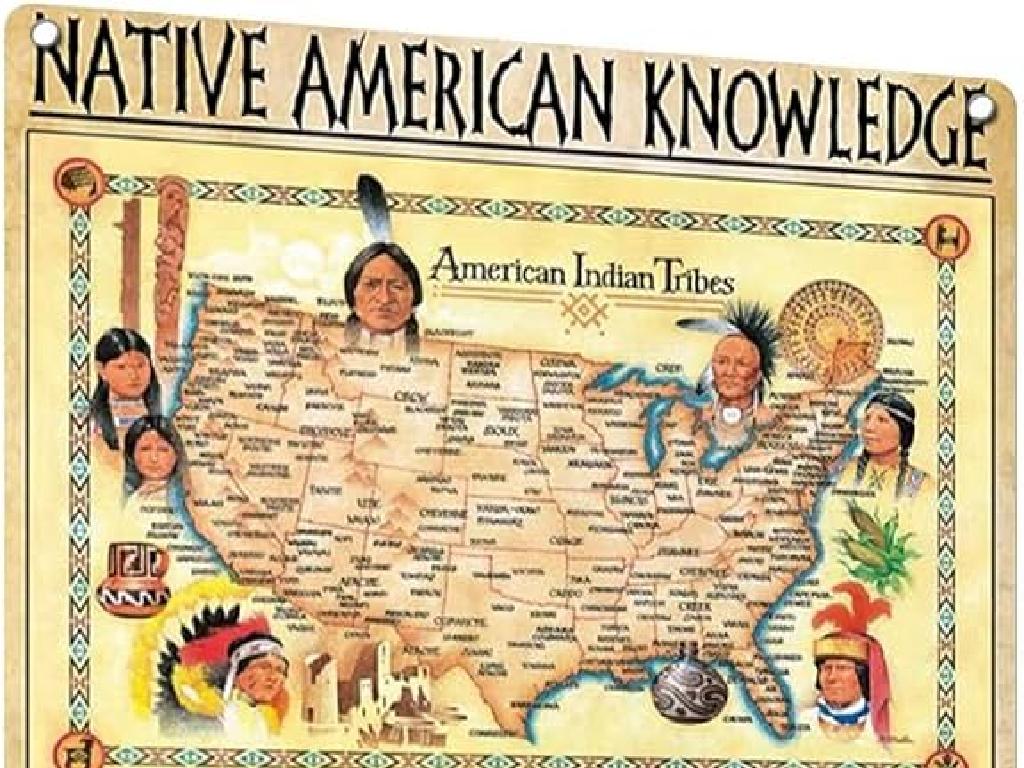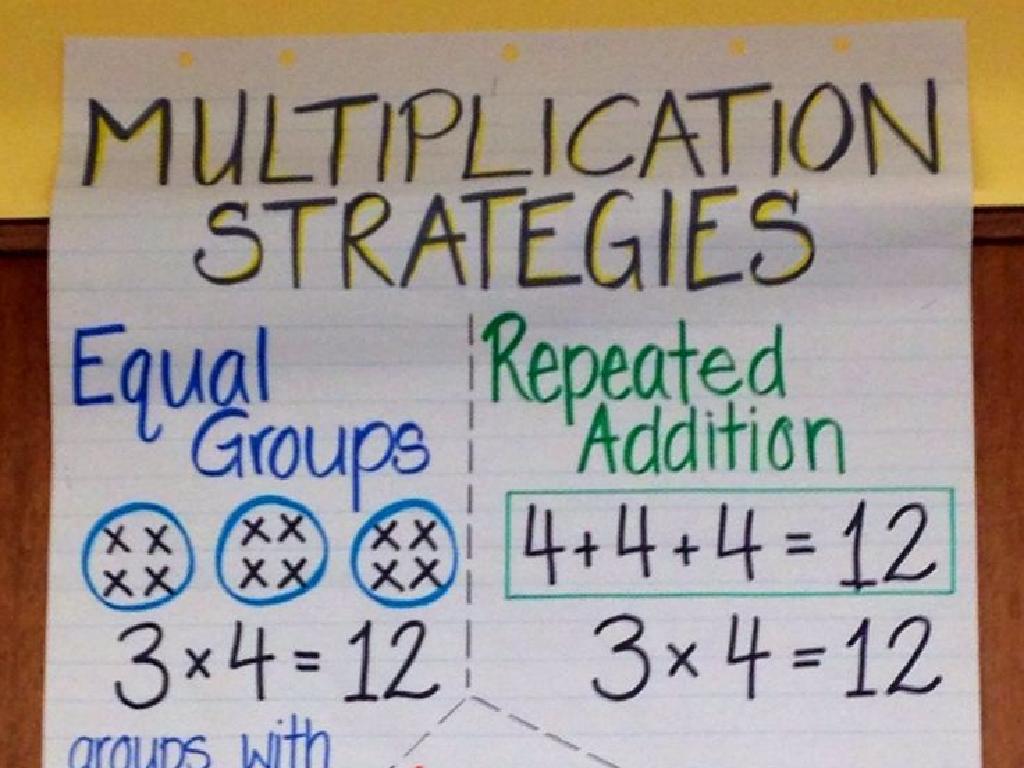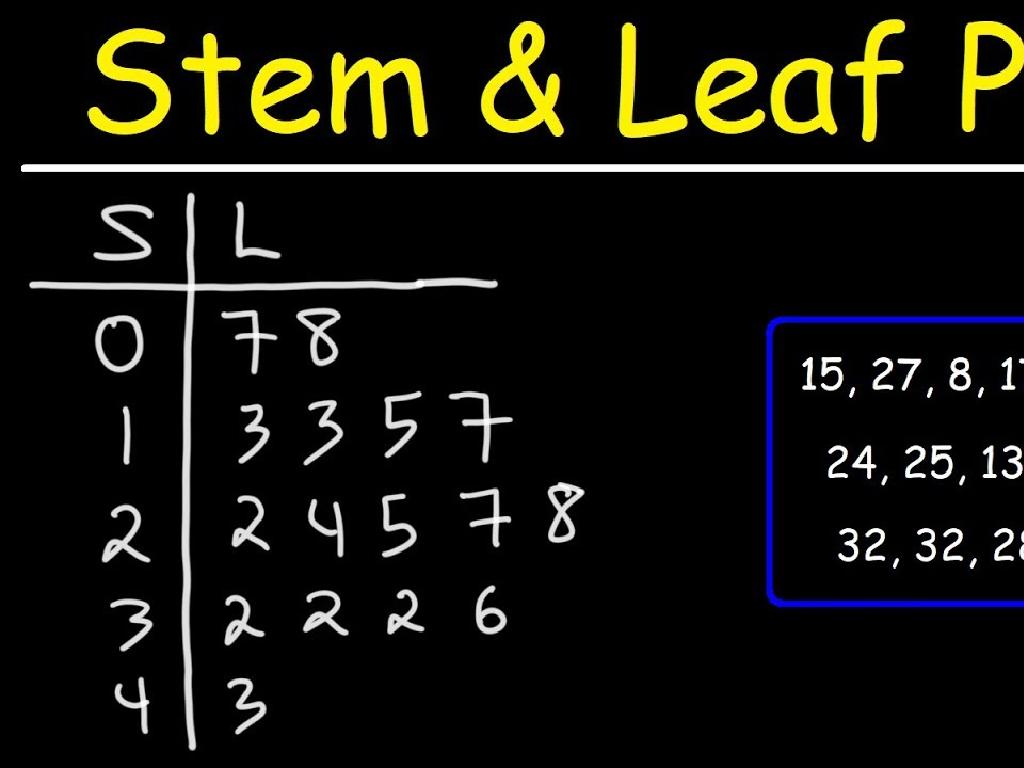Identify Multiplication Expressions For Equal Groups
Subject: Math
Grade: Third grade
Topic: Understand Multiplication
Please LOG IN to download the presentation. Access is available to registered users only.
View More Content
Welcome to Multiplication!
– Multiplication means groups of equal size
– If you have 3 groups of 4 apples, that’s 3 times 4 apples
– It’s like adding the same number over and over!
– Instead of saying 4 + 4 + 4, we can say 3 x 4
– Each group has the same number of items
– In 3 x 4, there are 3 groups with 4 in each group
– Practice makes you a multiplication master!
|
This slide introduces the concept of multiplication as grouping. Explain that multiplication is a way to add the same number multiple times, which is more efficient than addition when dealing with equal groups. Use concrete examples, like groups of apples, to illustrate the point. Emphasize that each group must have the same number of items for it to be multiplication. Encourage students to practice with different numbers to become comfortable with the concept. Activities can include using physical objects to create groups, drawing pictures to represent problems, or using multiplication games to reinforce the concept.
Understanding Multiplication: Equal Groups
– Multiplication creates equal groups
– It’s repeated addition
– Example: 3 groups of 2 apples
– Imagine having 2 apples, then getting 2 more, and 2 more
– Multiplication expression: 3 x 2
– 3 groups of 2 apples can be expressed as 3 times 2
|
This slide introduces the concept of multiplication as a method for combining equal groups. It’s important to convey that multiplication is a shortcut for adding the same number multiple times. Use the example of apples to illustrate this point, as it’s a tangible item that children can easily visualize. Explain that ‘3 groups of 2 apples’ means we have 2 apples, and we get 2 more apples two additional times, making it a total of 6 apples. This can be written as the multiplication expression ‘3 x 2’. Encourage students to think of other examples of equal groups in their daily life to reinforce the concept.
Visualizing Equal Groups
– Picture groups of objects
– Imagine groups of apples or toys
– Count totals with equal groups
– If you have 3 groups of 4 apples, how many apples do you have in total?
– Determine the number of groups
– How many groups can you make with 12 stars if each group has 4 stars?
– Calculate items per group
– If one group has 5 stars, how many stars are in 3 groups?
|
This slide is aimed at helping students visualize the concept of multiplication as a method of combining equal groups. Use tangible examples like toys or fruits to make the idea relatable. Encourage students to count the total number of items by grouping them equally and then to identify both the number of groups and the number of items in each group. This will help them understand the foundation of multiplication: repeated addition. For instance, if there are 3 groups of 4 apples, they can count by fours (4, 8, 12) to find the total. Activities can include grouping classroom items or using illustrations to solidify the concept.
Writing Multiplication Expressions
– Turn groups into multiplication
– First number: count of groups
– If we have 5 groups, the first number is 5
– Second number: items in a group
– If each group has 2 items, the second number is 2
– Example: 4 groups of 3 apples
– 4 groups of 3 apples is 4 x 3
|
This slide is aimed at helping third-grade students understand how to write multiplication expressions for equal groups. Start by explaining that multiplication is a quick way of adding the same number several times. The first number in a multiplication sentence represents the total number of equal groups, while the second number indicates how many items are in each group. Use concrete examples, such as fruits or classroom objects, to illustrate this concept. For instance, if we have 4 baskets with 3 apples each, we can write the multiplication expression as 4 x 3. Encourage students to visualize the groups and count the total number of items to confirm the multiplication result. Provide several examples and allow students to create their own multiplication sentences from given groups.
Let’s Practice Multiplication Together!
– I’ll demonstrate an example
– Count groups and write expression
– If we have 4 groups of 3 apples, what’s the expression?
– Share and explain our answers
– Discuss how we got our answers
– Understanding through practice
– Practice helps us learn multiplication!
|
This slide is designed for an interactive class activity to practice identifying multiplication expressions for equal groups. Start by showing an example on the board, such as ‘4 groups of 3 apples’. Work through the problem as a class, writing the multiplication expression ‘4 x 3’. Have students count the total number of items in the groups and write their own expressions. Then, ask volunteers to share their answers and explain the process they used to arrive at them. This will help students understand the concept of multiplication as repeated addition and how to express it mathematically. Encourage participation and provide positive feedback to ensure a supportive learning environment. Possible activities include using physical objects like counters or drawing groups on paper.
Your Turn: Multiplication Group Activity
– Form small groups for activity
– Use objects to create equal groups
– For example, 4 groups of 5 apples each
– Write multiplication expressions
– If you have 4 groups with 5 in each, write 4 x 5
– Help peers and prepare for sharing
|
This slide introduces a hands-on group activity to help students understand multiplication through the concept of equal groups. Divide the class into small groups and provide them with a variety of objects to arrange into equal groups. Encourage them to create their own multiplication expressions based on the groups they form. For instance, if a group has 4 sets of 5 apples, they should write the expression 4 x 5. Students should assist one another and be ready to explain their reasoning when sharing with the class. Possible activities: 1) Using counters to make groups, 2) Drawing groupings on paper, 3) Grouping classroom items, 4) Using stickers to represent groups, 5) Creating groups with linking cubes.
Class Activity: Multiplication Garden Craft
– Create your own multiplication flower
– Each petal represents a multiplication fact
– If your flower has 3 petals, and you make 4 flowers, that’s 3 x 4!
– Combine flowers to make a garden
– Visualize multiplication facts with flowers
– Seeing the flowers will help us remember 3 x 4 = 12
|
This creative activity is designed to help students understand and memorize multiplication facts through a hands-on craft. Each student will create a flower with a set number of petals. Each petal represents one unit in a multiplication fact. For example, a flower with 3 petals represents the number 3. If a student makes 4 such flowers, they are visualizing the multiplication fact 3 x 4. Once all students have made their flowers, combine them to create a ‘multiplication garden’ display in the classroom. This visual representation will aid in reinforcing the concept of multiplication as repeated addition and help students recall multiplication facts. Possible variations of the activity could include using different colors for different multiplication facts, adding leaves to represent another number to multiply, or creating flowers with different numbers of petals to represent various multiplication facts.
Review and Reflect: Multiplication and Equal Groups
– Recap of today’s multiplication lesson
– We learned that multiplication is adding equal groups together.
– Multiplication in daily life
– Understanding multiplication helps with quick calculations, like setting tables or buying multiple items.
– Discuss the benefits of equal groups
– Identifying equal groups simplifies complex problems into manageable steps.
– Share your interesting takeaways
– What did you find fun or intriguing in today’s lesson?
|
This slide aims to consolidate the day’s learning by encouraging students to reflect on the concept of multiplication as repeated addition of equal groups. Discuss how this understanding can be applied in real-life scenarios, such as organizing objects or managing time. Encourage students to share personal insights or enjoyable moments from the lesson to foster a sense of accomplishment and curiosity. This reflection not only reinforces the day’s learning but also connects it to practical situations, making the concept more relatable and memorable for the students.
Homework Challenge: Multiplication in the Real World
– Find equal groups around you
– Write multiplication expressions
– For example, 4 groups of 3 apples is 4 x 3
– Each group is a chance to learn
– Share your discoveries tomorrow
|
This homework task is designed to help students recognize and apply the concept of multiplication to their everyday environment. By identifying equal groups of objects at home or outside, students will practice writing multiplication expressions that correspond to these groups. Encourage them to think creatively and find a variety of examples, such as a carton of eggs (2 x 6 for the two rows of six eggs each) or a pack of juice boxes. Remind them to consider the number of groups and the number of items in each group to form their expressions. The next day, students will have the opportunity to share their findings, reinforcing their understanding and allowing them to see how their peers approached the assignment.





